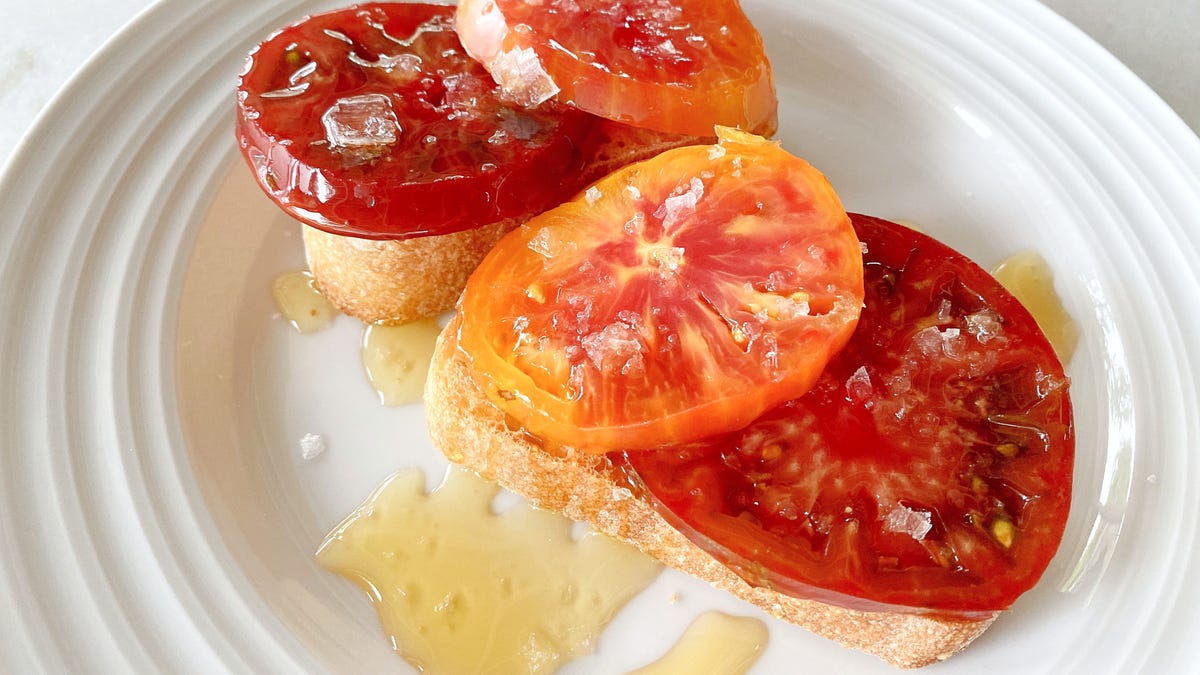Drizzle a Little Honey on Your Tomatoes
One of my favorite sides is exceedingly simple: sliced, fresh tomatoes with a little salt (extra credit if they’re served on Blue Willow china). Ripe summer tomatoes don’t need much adornment, and I tend to be mulish about involving...

One of my favorite sides is exceedingly simple: sliced, fresh tomatoes with a little salt (extra credit if they’re served on Blue Willow china). Ripe summer tomatoes don’t need much adornment, and I tend to be mulish about involving unnecessary ingredients, so when I saw a woman drizzling honey on her tomato toast, I scoffed. Surely the honey’s sweetness would overpower the tomato—or so I thought.
A few weeks later, I found myself with half a pint of cherry tomatoes threatening to lose their luster. I halved them and tossed them with some of the preserved feta my friend (and Lifehacker contributor) Amanda had made. The combo was good, but it needed something else. Then I remembered the honey.
Tomato tools:
A bread knife for perfect slicesHoney for drizzlingBlue Willow plates (for authentic Southern charm)Maldon salt, for flavor and textureI drizzled some on, swirled it about, then took a big bite. The feta and honey were marvelous together, but that’s to be expected; honey and cheese are a proven pair. What I didn’t expect was for the honey and tomato to get along so well. Rather than overpowering the fruit, the honey’s warm sweetness amplified and complemented the tomato’s acidic tanginess and umami-packed glutamates. Add a little salt (or cheese), and you’ve got a bite that hits every flavor note but bitter.
Unsatisfied with a single data point, I grabbed a few heirlooms to test a more stripped down approach. I toasted a piece of bread, sliced a couple of small tomatoes, and shingled the slices on the toast before finishing them with a few healthy drizzles of honey and several large pinches of Maldon flake salt.
The results were a little less straightforward this time. Before I drizzled on the honey, I gave each tomato a taste. The darker, burgundy-colored tomato was almost past ripe and nearly candy-sweet, with little acid. Drizzling honey on this tomato was essentially putting a hat on a hat—it wasn’t needed, and the result wasn’t balanced. That tomato was an outlier, however. I’ve had never tasted a tomato that sweet before, and I may never do so again, but I mention it so you’ll be armed with all the information you need to make the best tomato-related decisions during tomato season. There’s no reason to further sweeten an already overwhelmingly sweet piece of fruit, tomato or otherwise.
The second, orange tomato I tried was tangier and less sweet, and more in line with what I expect a tomato to taste like. It was a much better match for the honey. Again the tomato’s flavors were amplified instead of obscured, with the honey’s sweetness boosting the impact of the umami and acid, making the tomato taste more tomato-y by contrast. Try this on your next slicer, maybe with a little feta. (The feta isn’t “necessary,” but it is delicious, and it is necessary to enjoy a little deliciousness now and again.)

 Konoly
Konoly 
































